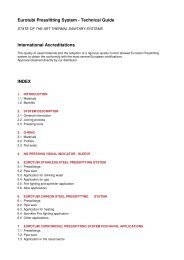corrosion of stainless steel - Damstahl
corrosion of stainless steel - Damstahl
corrosion of stainless steel - Damstahl
You also want an ePaper? Increase the reach of your titles
YUMPU automatically turns print PDFs into web optimized ePapers that Google loves.
Chapter 6 - Corrosion <strong>of</strong> Stainless Steel<br />
Pressure testing<br />
<strong>of</strong> pipe systems<br />
neutral water” (with e.g. 250 mg/l chloride, the maximum in EU tap water)<br />
is used, it is seen from Figure 6.10 that <strong>steel</strong> type 4301 only lasts to approx.<br />
50°C without suffering from pitting <strong>corrosion</strong>. If the chloride content is<br />
increased to 500 mg/l, the temperature is reduced to 38°C and at 2000 mg/l<br />
(= 0.2%) only 25°C is possible.<br />
The higher the chloride concentration, the poorer the <strong>corrosion</strong> resistance,<br />
which needs to be taken into consideration for e.g. pressure testing <strong>of</strong> pipe<br />
systems. It is possible that the <strong>steel</strong> will be fine in standard tap water with<br />
max. 250 mg/l during the pressure testing itself, but remaining drops <strong>of</strong><br />
water may cause problems. The water evaporates, but the salts do not,<br />
and the chloride content can easily become much higher than the original<br />
250 mg/l in the drops <strong>of</strong> water. This is the same evaporation effect that over<br />
thousands <strong>of</strong> years has created the Dead Sea, and several times <strong>corrosion</strong><br />
has occurred due to evaporation <strong>of</strong> the pressure testing water. Corrosion at<br />
the bottom <strong>of</strong> pipes after pressure testing indicates such damage.<br />
Figure 6.11:<br />
Remaining drops <strong>of</strong> water from e.g. pressure testing <strong>of</strong> pipe systems may<br />
cause unpleasant surprises. As the water evaporates, the salt content<br />
increases, and the conditions gradually become more corrosive. The risk<br />
<strong>of</strong> bacterial growth does not improve the situation.<br />
Extreme salt<br />
concentrations<br />
give low oxygen<br />
solubility<br />
If you look at the CPT curves in Figure 6.10, it can be seen that very<br />
high chloride concentrations almost make the curves run completely<br />
horizontally. This is a sign that there is no great difference between the<br />
<strong>corrosion</strong> conditions at 1% Cl – and 2% Cl – . At the lower end, a doubling <strong>of</strong><br />
the concentration has much greater effect which is not really as strange as<br />
it seems. With more than 1% chloride, the corrosive agents are so dominant<br />
that a bit more makes no difference.<br />
In practice, one may even encounter a 's<strong>of</strong>tening effect' at very high salt<br />
concentrations as the solubility <strong>of</strong> oxygen is lower in strong solutions than<br />
in weak ones. This <strong>of</strong>ten means that a high salt content is accompanied<br />
by a lower <strong>corrosion</strong> potential which may even improve the resistance to<br />
<strong>corrosion</strong> (see below in Section 6.2.3). Concentrated salt solutions are<br />
thus not necessarily worse than diluted ones as the increase in chloride<br />
is compensated for by a reduction in the <strong>corrosion</strong> potential - the driving<br />
force <strong>of</strong> the <strong>corrosion</strong>.<br />
If strong oxidants are present (e.g. peroxide or hypochlorite), the reduced<br />
solubility <strong>of</strong> oxygen unfortunately does not play a role, and the <strong>corrosion</strong><br />
conditions uniformly become worse at higher concentrations <strong>of</strong> chloride.<br />
Trying to improve the <strong>corrosion</strong> conditions by increasing the salt<br />
concentration is therefore not recommended.<br />
87<br />
RS for alle.indb 87<br />
9/29/2011 12:44:36 PM

















